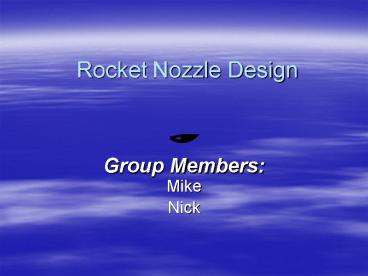Rocket Nozzle Design - PowerPoint PPT Presentation
1 / 33
Title: Rocket Nozzle Design
1
Rocket Nozzle Design
- Group MembersMike
- Nick
2
Introduction...Presentation Outline
- Introduction (Nick)
- Brief Theory / FLUENT Modeling (Mike)
- Literature / Experimental Data (Nick)
- Conclusion (Mike)
3
Introduction...Project Objectives
- To analyze four simplified nozzle geometries in a
model rocket and calculate their maximum thrust.
- Compare the theoretical and experimental thrust
of these nozzles. Choose the best nozzle based
on our data.
4
Introduction...Which simplifications?
- The Nozzle Configurations we modeled
- Orifice
- Converging Nozzle
- Diverging Nozzle
- Converging-Diverging
- (Click on links above to see the various
configurations)
5
Introduction...Rocket Particulars
- The type of rocket we modeled
- Solid Propellant / Core Burning
- Core burning rockets burn propellant from the
inside out.
This is in comparison to end-burning rockets
which burn propellant from the bottom up.
Graphic from http//www.sewanee.edu/physics/SEMIN
ARS/HTML20Rowland/sld011.htm
6
Introduction...Rocket Particulars
- The size of rocket we modeled
- 0.25 Inch diameter casing
- 2) 2.25 Inches Long
7
Brief TheoryHow to calculate thrust
The general thrust equation is given as follows
Graphic from http//members.aol.com/ricnakk/th_th
rst.html
8
GAMBITBoundaryConditions
9
GAMBITThe Mesh
Triangular Elements40 to 400 Intervals/Inch
10
FLUENTAssumptions
- Axisymmetric 2D Flow
- Steady State / Constant Pressure Inlet
- Compressible Flow
- Ideal Gas (air)
11
FLUENTParticular Settings
- On all configurations the iterations were run to
a residual of 1e-3 - Turbulent Flow (K-E model)
- Variable Density
- Used 2nd Order Equations to Calculate Density /
Pressure / Momentum
12
FLUENTVelocity Contour Plots
13
FLUENTPressure Contour Plots
14
FLUENTDensity Contour Plots
15
FLUENTResults
16
FLUENTGraphical Results
17
Literature
The preponderance of literature clearly shows the
Converging Diverging Nozzle as the most
efficient nozzle design.
Diagrams like this (right) are not uncommon
Graphic from http//www.nakka-rocketry.net/lambda
_p.html
18
Literature
Similar Pressure Trends
19
Experimental DataIntroduction
- Homemade rockets with these four various nozzle
geometries were built and tested. All thrust
values were measured and recorded.
20
Experimental DataExperimental Setup Method 1
Method 1 In this case the nozzle thrust was
downward onto the scale. Before ignition, a thin
metal plate was placed on top of the scale to
protect it from the flame.
21
Experimental DataTesting Using Method 1
For record keeping, a camcorder was zoomed up
close to the scale and recording.
Note the metal plate protecting the plastic of
the scale.
22
Experimental DataMethod 1 (Thrust Downward)
23
Experimental DataExperimental Setup Method 2
Method 2 In this case the nozzle was placed
into a hollow tube and thrust was directed
upward. Thus the rocket pushed onto the
scale.
24
Experimental DataTesting Using Method 2
Note the camcorder was zoomed up close to the
scale. (Right) Movie of Converging-Diverging
Run Click on Image to Play
25
Experimental DataData Using Method 2
We were able to go back and watch our results on
TV in slow motion.
26
Experimental DataMethod 2 (Thrust Upwards)
27
Conclusion
28
Next time
29
Questions?
30
Converging/Diverging
31
Diverging
32
Converging
33
Orifice

